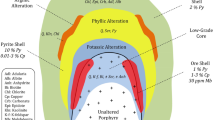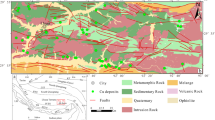Abstract
Factor analysis method is a multivariate analysis technique that is widely used for the interpretation of stream sediment geochemical data. The purpose of factor analysis is describing the changes in a set of multi-element geochemical data by reducing the dimension of the data and variables to a number of factors that can present the hidden association between elements. Differences in mobility, physical, and chemical properties of the elements and the nature of the factor analysis method in which the matrix of all data is used cause paragenes elements not to be found on the output of factor analysis. In this research, to improve the output of factor analysis for deriving the best reagent multi-element mineralization, robust staged factor analysis method was used according to the close nature of geochemical data in order to identify the Cu-mineralization potential in Khusf 1:100,000 sheets located at the east of Iran. The robust staged factor analysis enhances the recognition of anomalous geochemical signatures and increases geochemical anomaly intensity and the percentage of the total explained variability of data. As indicated by the results of the study, few anomalous zones have been found in the study area. The observation of chalcopyrite and malachite mineralization in andesite and dacite–andesite rocks in a region during the field study confirms the effectiveness of the robust SFA technique. Such studies can be used by mine engineers and geologists for designing an optimum grid exploration on the next exploration steps.






Similar content being viewed by others
References
Abdolmaleki M, Mokhtari AR, Akbar S, Alipour-Asll M, Carranza EJM (2014) Catchment basin analysis of stream sediment geochemical data: incorporation of slope effect. J Geochem Explor 140:96–103
Aitchison J (1986) The statistical analysis of compositional data. Monographs on statistics and applied probability. Chapman and Hall, London, 416 p
Aitchison J, Barceló-Vidal C, Martín-Fernández J, Pawlowsky-Glahn V (2000) Logratio analysis and compositional distance. Math Geol 32(3):271–275
Bai J, Porwal A, Hart C, Ford A, Yu L (2010) Mapping geochemical singularity using multifractal analysis: application to anomaly definition on stream sediments data from Funin Sheet, Yunnan, China. J Geochem Explor 104(1):1–11
Basilevsky A (1994) Statistical factor analysis and related methods. Theory and applications. Wiley, New York, 737 pp
Berberian M (2000) The 1994 SefidaBeh earthquakes in Eastern Iran: blind thrusting-plane slip on A1 growing A1 antic line, & active tectonic s of the Sistan Suture Zone. Geophys J Int 142:283–299
Berberian F, Muir ID, Pankhurst RJ, Berberian M (1982) Late cretaceous and early miocene andeantype plutonic activity in northern Makran and Central Iran. J Geol Soc 139:605–614
Bishop CM (2006) Pattern recognition and machine learning, (Vol. 1). Springer, New York
Bonham-carter GF, Goodfellow DJ (1986) Background corrections to stream geochemical data using digitized drainage and geological maps: application to Selwyn Basin, Yukon and Northwest Territories. J Geochem Explor 25:139–155
Bonham-carter GF, Rogers PJ, Ellwood DJ (1987) Catchment basin analysis applied to surficial geochemical data, Cobequid Highlands, Nova Scotia. J Geochem Explor 29:259–278
Borovec Z (1996) Evaluation of the concentrations of trace elements in stream sediments by factor and cluster analysis and the sequential extraction procedure. Sci Total Environ 177(1):237–250
Buccianti A, Pawlowsky-Glahn V (2005) New perspectives on water chemistry and compositional data analysis. Math Geol 37:703–727
Buccianti A, Mateu-Figueras G, Pawlowsky-Glahn V (eds) (2006) Compositional data analysis in the geosciences: from theory to practice. Geol Soc Lond
Carranza EJM (2008) Geochemical anomaly and mineral prospectivity mapping in GIS, vol 11. Elsevier
Carranza EJM (2010) Mapping of anomalies in continuous and discrete fields of stream sediment geochemical landscapes. Geochem Explor Environ Anal 10:171–187
Carranza EJM (2011) Analysis and mapping of geochemical anomalies using logratio-transformed stream sediment data with censored values. J Geochem Explor 110:167–185
Chen G, Cheng Q, Liu T, Yang Y (2013) Mapping local singularities using magnetic data to investigate the volcanic rocks of the Qikou depression, Dagang oilfield, eastern China. Nonlinear Process Geophys 20:501–511
Cheng Q, Agterberg FP, Bonham-Carter GF (1996) A spatial analysis method for geochemical anomaly separation. J Geochem Explor 56:183–195
Cheng Q, Xu Y, Grunsky E (2000) Integrated spatial and spectrum method for geochemical anomaly separation. Nat Resour Res 9:43–52
Daneshfar B, Desrochers A, Budkewitsch P (2006) Mineral-potential mapping for MVT deposits with limited datasets using Landsat data and geological evidence in the Borden Basin, Northern Baffin Island, Nunavut, Canada. Nat Resour Res 15:129–149
Darwish MAG, Poellmann H (2010) Geochemical exploration for gold in the Nile Valley block (A) area, Wadi Allaqi, South Egypt. Chem Erde 70:353–362
Egozcue JJ, Pawlowsky-Glahn V, Mateu-Figueras G, Barceló-Vidal C (2003) Isometric logratio transformations for compositional data analysis. Math Geol 35(3):279–300
Filzmoser P, Hron K (2008) Outlier detection for compositional data using robust methods. Math Geosci 40(3):233–248
Filzmoser P, Hron K (2009) Correlation analysis for compositional data. Math Geosci 41(8):905–919
Filzmoser P, Hron K, Reimann C (2009a) Principal component analysis for compositional data with outliers. Environmetrics 20(6):621–632
Filzmoser P, Hron K, Reimann C (2009b) Univariate statistical analysis of environmental (compositional) data: problems and possibilities. Sci Total Environ 407(23):6100–6108
Filzmoser P, Hron K, Reimann C, Garrett R (2009c) Robust factor analysis for compositional data. Comput Geosci 35(9):1854–1861
Filzmoser P, Hron K, Reimann C (2010) The bivariate statistical analysis of environmental (compositional) data. Sci Total Environ 408(19):4230–4238
Garrett RG (2013) The ‘rgr’ package for the R open source statistical computing and graphics environment-a tool to support geochemical data interpretation. Geochem Explor Environ Anal 13(4):355–378
Hassani Pak AA, Sharafodin M (2011) Exploration data analysis. ISBN 978-964-03-4459-0
Kaiser HF (1958) The varimax criterion for analytic rotation in factor analysis. Psychometrika 23(3):187–200
Karimpour M (2011) Review of age, Rb-Sr geochemistry and petrogenesis of Jurassic to quaternary igneous rocks in Lut Block, Eastern Iran. Geopersia 1(1):19–54
Lapworth DJ, Knights KV, Key RM et al (2012) Geochemical mapping using stream sediments in west-central Nigeria: implications for environmental studies and mineral exploration in West Africa. Appl Geochem 27:1035–1052
Lepeltier C (1969) A simplified statistical treatment of geochemical data by graphical representation. Econ Geol 64:538–550
Liu Y, Cheng Q, Xia Q, Wang X (2014) Multivariate analysis of stream sediment data from Nanling metallogenic belt, South China. Geochem Explor Environ Anal 14(4):331–340
Martín-Fernández JA, Hron K, Templ M, Filzmoser P, Palarea-Albaladejo J (2012) Model-based replacement of rounded zeros in compositional data: classical and robust approaches. Comput Stat Data Anal 56(9):2688–2704
Mokhtari AR, Abdolmaleki M, Akbar S (2013) Geochemical stream sediment catchment basin modeling method. Iran J Min Eng (IRJME) 8(19):67–76
Ohta A, Imai N, Terashima S, Tachibana Y (2005) Influence of surface geology and mineral deposits on the spatial distributions of elemental concentrations in the stream sediments of Hokkaido, Japan. J Geochem Explor 86(2):86–103
Pawlowsky-Glahn V, Egozcue J (2006) Compositional data and their analysis: an introduction. Geol Soc Lond, Spec Publ 264(1):1–10
Pawlowsky-Glahn V, Egozcue JJ, Tolosana-Delgado R (2015) Modelling and analysis of compositional data. Wiley, Chichester
Porwal A, Carranza EJM, Hale M (2003) Knowledge-driven and data-driven fuzzy models for predictive mineral potential mapping. Nat Resour Res 12:1–25
Reimann C (2005a) Geochemical mapping: technique or art? Geochem Explor Environ Anal 5:359–370
Reimann C (2005b) Sub-continental-scale geochemical mapping: sampling, quality control and data analysis issues. Geochem Explor Environ Anal 5:311–323
Reimann C, Filzmoser P, Garrett RG (2002) Factor analysis applied to regional geochemical data: problems and possibilities. Appl Geochem 17(3):185–206
Reimann C, Filzmoser P, Garrett RG (2005) Background and threshold: critical comparison of methods of determination. Sci Total Environ 346:1–16
Rietveld T, Van Hout R (1993) Statistical techniques for the study of language and language behaviour. Mouton de Gruyter, Berlin – New York
Rousseeuw PJ, Van Driessen KV (1999) A fast algorithm for the minimum covariance determinant estimator. Technometrics 41(3):212–223
Saager R, Esselaar PA (1969) Factor analysis of geochemical data from the Basal Reef, Orange Free State Goldfield, South Africa. Econ Geol 64:445–451
Saager R, Singlair AJ (1974) Factor analysis of stream sediment geochemical data from the Mount Nansen area, Yujon territory, Canada. Mineral Deposita 9:243–252
Shiva M (1998) Stream sediment geochemical exploration in the arid environment of East Iran. PhD thesis, the University of Natingham, UK
Spadoni M (2006) Geochemical mapping using a geomorphologic approach based on catchments. J Geochem Explor 90(3):183–196
Stocklin J, Nabavi MH (1973) Tectonic map of Iran. Geological Survey of Iran
Theodoridis S, Koutroumbas K (2006) Pattern recognition, 2nd edn. Academic Press, Elsevier, USA
Tirrul R, Bell IR, Griffis RJ, Camp VE (1983) The Sistan suture zone of eastern Iran. Geol Soc Am Bull 94:134–156. doi:10.1130/0016-7606(1983)94<134:TSSZOE>2.0.CO;2
Treiblmaier H, Filzmoser P (2010) Exploratory factor analysis revisited: how robust methods support the detection of hidden multivariate data structures in IS research. Inf Manag 47(4):197–207
Tripathi VS (1979) Factor analysis in geochemical exploration. J Geochem Explor 11(3):263–275
Tukey JW (1977) Exploratory data analysis. Addison-Wesley, Reading
Vahdati F (1989) Geological map of Khosf (1:100,000). Geological Survey of Iran Publication
Van Helvoort P-J, Filzmoser P, van Gaans PF (2005) Sequential factor analysis as a new approach to multivariate analysis of heterogeneous geochemical datasets: an application to a bulk chemical characterization of fluvial deposits (Rhine–Meuse delta, The Netherlands). Appl Geochem 20(12):2233–2251
Wilde AR, Bierlein FP, Pawlitschek M (2004) Lithogeochemistry of orogenic gold deposits in Victoria, SE Australia: a preliminary assessment for undercover exploration. J Geochem Explor 84:35–50
Yousefi M, Kamkar-Rouhani A, Carranza EJM (2012) Geochemical mineralization probability index (GMPI): a new approach to generate enhanced stream sediment geochemical evidential map for increasing probability of success in mineral potential mapping. J Geochem Explor 115:24–35
Yousefi M, Kamkar-Rouhani A, Carranza EJM (2014) Application of staged factor analysis and logistic function to create a fuzzy stream sediment geochemical evidence layer for mineral prospectivity mapping. Geochem Explor Environ Anal 14(1):45–58
Zuo R (2011) Identifying geochemical anomalies associated with Cu and Pb–Zn skarn mineralization using principal component analysis and spectrum–area fractal modeling in the Gangdese Belt, Tibet (China). J Geochem Explor 111:13–22
Zuo R, Xia Q, Wang H (2013) Compositional data analysis in the study of integrated geochemical anomalies associated with mineralization. Appl Geochem 28:202–211
Acknowledgments
The authors would like to express their appreciations to the authorities of the South Khorasan Industry, Mine & Trade Organization who provided the facilities for doing this research. The financial support of the University of Birjand is gratefully thanked.
Author information
Authors and Affiliations
Corresponding author
Rights and permissions
About this article
Cite this article
Keykha Hoseinpoor, M., Aryafar, A. Using robust staged R-mode factor analysis and logistic function to identify probable Cu-mineralization zones in Khusf 1:100,000 sheets, east of Iran. Arab J Geosci 9, 157 (2016). https://doi.org/10.1007/s12517-015-2266-9
Received:
Accepted:
Published:
DOI: https://doi.org/10.1007/s12517-015-2266-9




